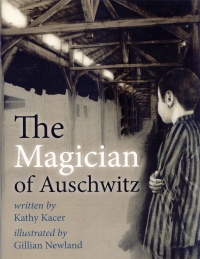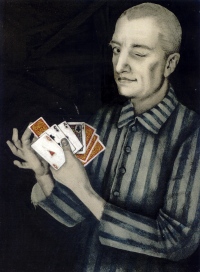| ________________
CM . . .
. Volume XXI Number 1. . . .September 5, 2014 
 |
The Magician of Auschwitz.
Kathy Kacer. Illustrated by Gillian Newland.
Toronto, ON: Second Story Press, 2014.
32 pp., hardcover, $18.95.
ISBN 978-1-927583-46-3.
Subject Headings:
Reich, Werner-Juvenile literature.
Nivelli, Herbert, 1906-1977-Juvenile literature.
Holocaust, Jewish (1939-1945)-Juvenile literature.
Jewish children in the Holocaust-Biography-Juvenile literature.
Magicians-Germany-Biography-Juvenile literature.
Auschwitz (Concentration camp)-Juvenile literature.
Grades 2-5 / Ages 7-10.
Review by Reesa Cohen.
**** /4
Reviewed from Advance Reading Copy.
|
| |
|

excerpt:
Once. there was a renowned magician called Nivelli who performed before packed audiences in the grandest theaters of Berlin. Night after night, his fans applauded and called out for more astonishing feats of magic. “Bravo!” they would shout, as Nivelli bowed low with a great flourish. But that was a different, happier time, before the Jews of Europe were rounded up and sent to concentration camps....
It was called the Family Camp of Auschwitz. But when Werner entered the barrack where he was to stay, he knew that this place was truly a prison. Wooden bunks lined the sides of the timber building. No pillows, no blankets, no mattresses-not even straw-cushioned the beds. Men and older boys were kept on this side of the camp. Women and young children were kept separately.
In just these two short paragraphs above, Kacer sets a somber tone for a difficult, yet fascinating, story. In this grim place, Werner tries to be brave and strong, and he is helped in this efforts by his older bunkmate who has the number A1676 tattooed on his arm. He introduces himself as Levin, and Werner shows him his own tattooed number. Even under these frightening circumstances, Werner remembers to be polite and respectful as each shares a bit of his story with the other. Levin’s kindness is welcomed, and he encourages Werner to have hope. The story, itself, reveals the everyday horror that the prisoners experienced. Besides the indignity of the tattoos and the impossible sleeping conditions, there was constant hunger, daily hard labour, the despair of losing one’s family, the shaved heads, the hours of standing in lines to be counted again and again, the terror inflicted by the guards and, of course, the loneliness. One night Werner’s sleep is interrupted by the guards demanding of Levin, “Do your Magic!”
 Werner is fascinated by Levin’s ability to perform the amazing tricks he was forced to do by the guards on many nights. In his naivety, the young boy thinks that Levin is performing tricks to entertain the guards and will be rewarded, but the gifted magician soon makes it clear that “he was performing for his life!” When Werner is upset at having some of his food stolen, Levin patiently teaches Werner a card trick to help distract him from his hunger and fear. “In this dreadful place, where there was nothing to own and nothing to give, the magician had given Werner a gift.” Werner is fascinated by Levin’s ability to perform the amazing tricks he was forced to do by the guards on many nights. In his naivety, the young boy thinks that Levin is performing tricks to entertain the guards and will be rewarded, but the gifted magician soon makes it clear that “he was performing for his life!” When Werner is upset at having some of his food stolen, Levin patiently teaches Werner a card trick to help distract him from his hunger and fear. “In this dreadful place, where there was nothing to own and nothing to give, the magician had given Werner a gift.”
After the surviving prisoners in this concentration camp were liberated, the two never saw each other again. Many, many years later, Werner, who never forgot the kindness of this magician, teaches his own sons some of his card tricks.
Newland’s illustrations reflect the haunting dark tone of the story with the use of grays, blacks, and greens. The murky palette, the black framed pictures, the gloomy darkness, all help to convey the chilling and disturbing nature of the story.
What makes this book even more poignant and compelling is the fact that it is based on a true story. A section at the end of the book has photographs of the real Werner and the famous Nivelli and some details from their lives. It is particularly fascinating that both survived the war and came to the United States. Werner never realized that Levin continued to perform magic in America under his original stage name of Nivelli till he died in 1977. It was only when Werner read an article about Levin, one that mentioned Levin’s tattooed number, did Werner recognize him as the kind magician who gave him hope and helped mask the horror of his daily life in a concentration camp. A nice touch would be to share with students one of the YouTube videos of Werner Reich being interviewed as he recalls his meeting the magician in the camp.
It is never easy reading a book about the Holocaust, especially one targeted specifically for young readers. One wonders how a school-aged child will react. How could a young person possibly understand a time when human life for a Jew was so fragile? And that is the very reason that books like this must written and used in classrooms. There is a need to continue to shine a spotlight on the past. The challenge for any writer telling children about this horrific time is balance... truth without all the terrifying details. Kathy Kacer rises to this challenge and knows how important it is that children learn about this tragic time in history. She manages the daunting task to not glorify, sensationalize or sugarcoat all the facts. As an author of books in the award-winning “Holocaust Remembrance Series for Young Readers,” Kacer proves that you can talk to young people about serious and sad issues. Books in the series, such as Clara’s War, Hiding Edith and Hana’s Suitcase, can and should resonate with children from all cultures and walks of life. In fact, educators can use books like this as an entry point to discuss what life might have been like for young people at this time and use it as a opportunity and a vehicle to draw upon current events for other examples of situations today that threaten the well-being of other ethnic groups.
Highly Recommended.
Reesa Cohen is a retired Instructor of Children’s Literature and Information Literacy at the Faculty of Education, University of Manitoba in Winnipeg, MB.

To comment
on this title or this review, send mail to cm@umanitoba.ca.
Copyright © the Manitoba Library Association. Reproduction for personal
use is permitted only if this copyright notice is maintained. Any
other reproduction is prohibited without permission.
Next Review |
Table of Contents for This Issue
- September 5, 2014.
CM Home | Back Issues
| Search
| CM Archive
| Profiles Archive
|

 Werner is fascinated by Levin’s ability to perform the amazing tricks he was forced to do by the guards on many nights. In his naivety, the young boy thinks that Levin is performing tricks to entertain the guards and will be rewarded, but the gifted magician soon makes it clear that “he was performing for his life!” When Werner is upset at having some of his food stolen, Levin patiently teaches Werner a card trick to help distract him from his hunger and fear. “In this dreadful place, where there was nothing to own and nothing to give, the magician had given Werner a gift.”
Werner is fascinated by Levin’s ability to perform the amazing tricks he was forced to do by the guards on many nights. In his naivety, the young boy thinks that Levin is performing tricks to entertain the guards and will be rewarded, but the gifted magician soon makes it clear that “he was performing for his life!” When Werner is upset at having some of his food stolen, Levin patiently teaches Werner a card trick to help distract him from his hunger and fear. “In this dreadful place, where there was nothing to own and nothing to give, the magician had given Werner a gift.”